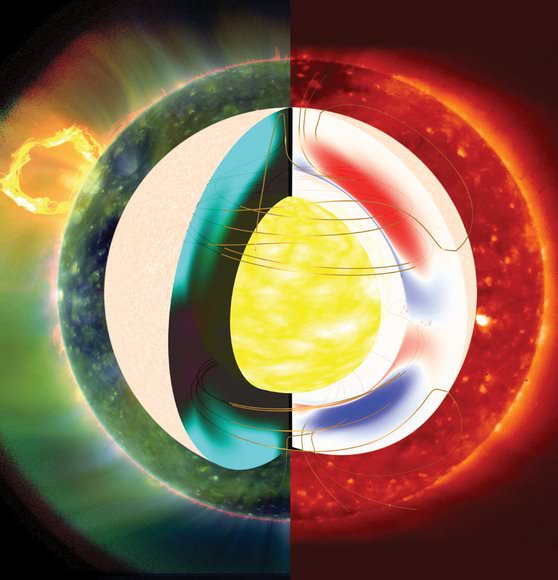[/caption]
The long lull in sunspots at the end of Solar Cycle 23 wasn’t just fodder for global cooling predictions — it gave solar physicists plenty to study. And a new computer analysis may have come up with a fairly simple explanation for the sun’s odd quiet. Lead author Dibyendu Nandy, of the Indian Institute of Science Education and Research in Kolkata, and his colleagues report in Nature today that the long string of sunspot-free days between solar cycles 23 and 24 may directly correlate with the speed of north-south flow of plasma toward the sun’s equator. Their collage, above, shows magnetic fields in the interior of the Sun simulated using a solar dynamo model (center) and the observed solar corona at two different phases of solar activity: A quiescent phase during the recent, unusually long minimum, at right, and a comparatively active phase following the minimum, at left.

The sun’s magnetic activity varies periodically, exhibiting an ~11-year cycle that can be monitored by observing the frequency and location of sunspots. Sunspots are strongly magnetized regions generated by the sun’s internal magnetic field and are the seats of solar storms that generate beautiful auroras but also pose hazards to satellites, navigation technologies like GPS and communications infrastructures.
Towards the end of solar cycle 23, which peaked in 2001 and wound down in 2008, the Sun’s activity entered a prolonged minimum, characterized by a very weak polar magnetic field and an unusually large number of days without sunspots: 780 days between 2008 and 2010. In a typical solar minimum, the sun goes spot-free for about 300 days, making the last minimum the longest since 1913.
The study authors conducted magnetic dynamo simulations of 210 sunspot cycles spanning some 2,000 years while varying the speed of the solar internal meridional (north-south) plasma flow. The sun’s plasma flows much like Earth’s ocean currents: rising at the equator, streaming toward the poles, then sinking and flowing back to the equator. At a typical speed of 40 miles per hour, it takes about 11 years to make one loop.
Nandy and his colleagues discovered that the Sun’s plasma rivers speed up and slow down like a malfunctioning conveyor belt, probably due to complicated feedback between the plasma flow and solar magnetic fields.
“It’s like a production line – a slowdown puts distance between the end of the last solar cycle and the start of the new one,” said study co-author Andres Munoz-Jaramillo, a visiting research fellow at the Harvard-Smithsonian Center for Astrophysics.
Specifically, the authors write, a fast meridional flow in the first half of a cycle, followed by a slower flow in the second half, leads to a deep sunspot minimum — and can reproduce the observed characteristics of the cycle 23 minimum.
Nandy and his colleagues say continued solar observations will be key to confirming and elaborating on the modeling results.
“We anticipate that NASA’s recently launched Solar Dynamics Observatory will provide more precise constraints on the structure of the plasma flows deep in the solar interior, which could be useful for complementing these simulations,” they write.
Source: Nature and the Harvard-Smithsonian Center for Astrophysics.


The Sun has no spot. To know the fact visit: http://www.spacemirrormystery.com
smoke and mirrors?
Just because you are paranoid does not mean they don’t know where you live… 😉
I had a looked moments ago, and it looks like spots to me!!
I.e. Sunspot No. 83 See the legitimate site at http://www.spaceweather.com/
“Who’s more foolish. The fool or the fool that follows him!”
Obi-Wan Kenobi; Star Wars Episode IV
“Never argue with a fool for he is doing the same” Les Barker: “Detritus”
I thought I heard it all.
But as usual, big claims but zero scientific facts.
One of these days I ave to invent some pseudo-science myself and start a web site; LOL I always liked the idea of a wild snarlak that just appears.